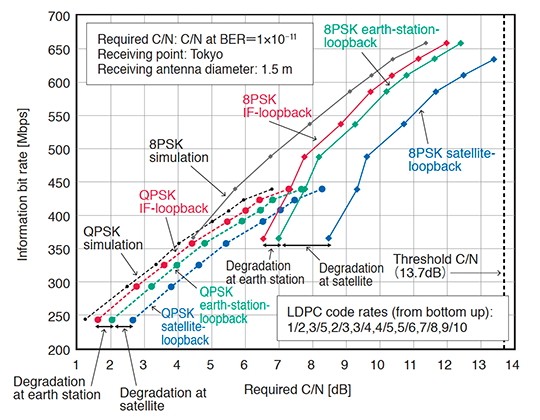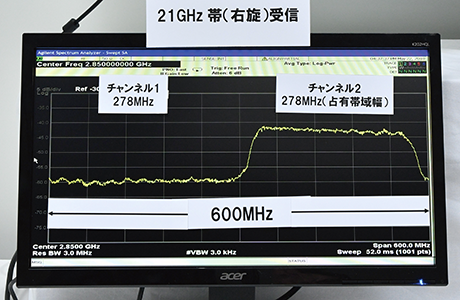Research Area
2.7 Satellite broadcasting technology
We are researching 12-GHz-band satellite broadcasting system that provides BS digital broadcasting services and 4K/8K UHDTV BS broadcasting services to improve the satellite transmission performance, and researching next-generation satellite broadcasting systems such as 21-GHz-band satellite broadcasting, which is considered as a promising transmission channel for future new broadcasting services.
■12-GHz-band satellite broadcasting
The 4K/8K UHDTV satellite broadcasting using ISDB-S3 (Integrated Services Digital Broadcasting for Satellite, 3rd generation), a transmission system researched and developed by NHK STRL, was officially started on December 1, 2018. Prior to the start, we evaluated the transmission performance of 16APSK (Amplitude Phase Shift Keying) by the BSAT-4a broadcasting satellite launched in 2017. The evaluation results demonstrated that adequate transmission performance with a required carrier-to-noise ratio (C/N) of 12.2 dB was obtained.
With the aim of increasing the capacity of 12-GHz-band satellite broadcasting by using multi-level modulation for more effective use of ISDB-S3, we are investigating a way of increasing the output power of the broadcasting satellite transmission. Since the side lobes of an on-board antenna, which cause radio wave interference to other countries, need to be suppressed when the output power is increased, we designed a reflector antenna with a wider aperture area by using a super-elliptical-shaped main reflector. We confirmed that the antenna, which takes an offset Gregorian type with 2.5 m aperture diameter considering the mountability onto the satellite body, reduced the side lobes by about 3 dB. Besides, for simplified reception of satellite broadcasting using a modulation scheme with a low required C/N, we also designed a compact flat receiving antenna for 12-GHz-band satellite broadcasting which does not require elevation adjustment when installed. The antenna uses patch antennas as elements and has an array structure that provides a phase difference in power feeding to each element, which achieved an elevation angle of 39 degrees, a maximum gain of 16 dBi and a half-power angle of 22 degrees for an aperture with sides of about 10 cm.
■Next-generation satellite broadcasting
Using a 21-GHz-band transponder mounted on BSAT-4a, we conducted experiments on satellite transmission of 300-MHz-class wide-band signals. We evaluated the C/N-to-BER performance of wide-band signal transmission using the modulation scheme (QPSK, 8PSK) and LDPC (Low Density Parity Check) code rate as parameters for different loopback types of "intermediate frequency (IF)-loopback," which loops back the signals in our prototype modulator and demodulator, "earth-station-loopback," which loops back the signals by in the transmitting earth station, and "satellite-loopback," which goes through BSAT-4a (Figure 2-16). The required C/N of satellite-loopback degraded by 1.0 dB compared to IF-loopback when using the QPSK modulation while it degraded by 1.8 to 2.2 dB when using 8PSK. These experiments clarified the relationship between the information bit rate that can be transmitted by BSAT-4a and the required C/N in the 21GHz band. We also conducted the world's first experiments on 4K and 8K multiplexing transmission using a 21-GHz-band broadcasting satellite (Figure 2-17)(1).
To evaluate rain attenuation characteristics in the 21 GHz band, in April 2018, we started measuring the receiving power of a left-hand circular polarization (LHCP) beacon signals constantly transmitted from BSAT-4a by using a 21-GHz-band receiving parabolic antenna with 1.5 m aperture diameter set up on the rooftop of our laboratory. We also installed a 21-GHz-band rain attenuation monitor station in NHK Fukuoka Broadcast station to evaluate rain attenuation characteristics in the 21 GHz band by region.
We prototyped interface devices for inputting and outputting IP signals to/from the wideband modulator and demodulator for 21-GHz band transmission using BSAT-4a. These devices enabled the transmission of MMT signals and other IP signals in the 21-GHz band broadcasting satellite.
We are studying a way to increase the output satellite transmission power by spatial synthesis using a 21-GHz-band array-fed reflector antenna. We designed a two-shaped-reflector antenna using a sequential array structure in which six-element horn antennas are arranged with rotational symmetry and confirmed that it can obtain a gain of about 37 dBi in major areas across the country when the cross-polarization discrimination is 27 dB or more.
With the aim of further increasing the capacity of satellite transmission, we prototyped a transmitter/receiver equipped with 64APSK coded modulation based on set partitioning and evaluated its performance in an environment with AWGN (Additive White Gaussian Noise). The prototype device was capable of up to 158.6-Mbps transmissions in a satellite transponder with a bandwidth of 34.5-MHz. Comparison with computer simulations showed that the required C/N degradation attributed to hardware was about 1.0 dB, and it was confirmed that the device had adequate transmission performance.

Figure 2-16. Required C/N vs. information bit rate during 21-GHz-band satellite transmission (performance measured with a prototype modulator and demodulator)

Figure 2-17. Received signal spectrum in 21-GHz-band satellite transmission experiment
| [References] | |
| (1) | Y. Suzuki et.al: "21-GHz Wide-band satellite transmission experiment with BSAT-4a broadcasting satellite," IEICE Technical report, Vol.118, No.136, SAT2018-14, p.19-23 (2018) (in Japanese) |